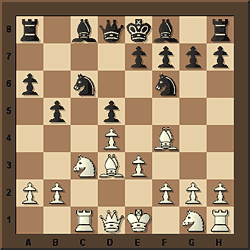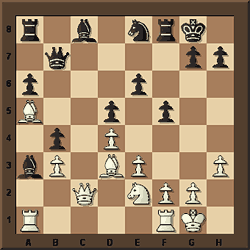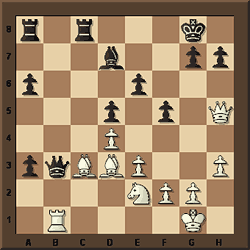I will take this opportunity to show you one further game, played some 20 years after I employed my novelty against Chebanenko. Playing in Rumania, with the black pieces against a local player, I again employed the Slav, and one of the variations I had worked out, involving the move 4...a6. But here I played a6 as early as move 3, trying to lure my opponent from well-known paths. Thanks partly to this, the Rumanian master “helped” me to create the best tournament game I have ever played, one for which I won the brilliancy prize in the tournament concerned. In this game, I sacrificed a whole set of pieces – first two pieces for a rook, then queen for rook, and on the followed move, a further exchange. This game also proved to be my last – since that day, I have never played in another official tournament.
It all happened when, in 1993, my daughter Almira was invited to play in Odorhe-Sekuesk. I had not played for about 20 years by that time, and I accompanied Almira to the tournament in a non-playing capacity. But it turned out that the organisers and journalists wanted father and daughter to play in the tournament together. The press had already prepared their headline: “The daughter outstrips the father!” However, to my mind, I played very well, scoring 6.5 out of 9. Here is this historic game:
Bencze,J - Skripchenko,Feodor [D10]
Odorhei-Secuesc, 17.06.1993
1.d4 d5 2.c4 c6 3.Nc3 a6! 4.cxd5 cxd5 5.Bf4 Nc6 6.e3 Nf6 7.Bd3 b5 8.Rc1
8...Qb6. Of course, the move 8…е6 was objectively stronger, as shown by the variation 8...e6 9.Nf3 Be7 10.0-0 0-0 11.Na4 Bb7 12.Nc5 Qb6 13.Ne5 Rfc8 14.Ng4 Ne8 15.Qb3 Nd6. However, the move 8…Qb6 also deserves attention, because it leads to some interesting possibilities for Black.
9.Nge2 e6 10.0-0 Be7 11.h3 0-0 12.a3 Na5 13.Nb1 Nc4 14.b3 Nxa3 15.Nxa3 Bxa3 16.Bc7 Qb7 17.Ba5 Ne8 18.Qc2 f5 19.Ra1 b4
20.Ng3?–/=. Stronger was 20.Nc3! Bd7 21.Nb1 Nd6 22.Nxa3 bxa3 23.Rfc1 (23.Rxa3 Rfc8 24.Qd2 Bb5=) with roughly equal chances. But my opponent had prepared a “trap”, winning two pieces for a rook. I decided to fall into it. 20...Bd7 21.Qe2 Nd6 22.Ra2 Nb5 23.Qh5 Nc3 24.Rxa3 bxa3 25.Bxc3 Qxb3 26.Ne2 Rfc8 27.Rb1.
Having two powerful bishops for a rook, and a powerful position on the queenside, White was looking forward to a quick victory. However, an unpleasant surprise awaited him: 27...Rxc3!! 28.Rxb3 Rxb3 29.Nc1. And here White got another surprise: 29...Rxd3! Of course, the rook cannot be taken, since Black queens a pawn. There followed: 30.Qe2 Rc3 31.Na2 Rb3 32.Qc2 Rab8 33.Qc7 R8b7 34.Qc5 Kf7 35.Kh2 Bb5 36.Nc1 Rb1 37.Qxa3 Bc4 38.Kg3 Kg8 39.Kf3 R1b2 40.g3 h6 41.g4 fxg4+ 42.Kxg4 Rxf2 43.Qd6 Rf6 44.h4 Rg6+ 45.Kh5 Kh7 46.Qe5 Rb2 47.e4 Rgg2 48.Qc7 Bb5 and White resigned. 0-1. [Click to replay]
This game won the first brilliancy prize in the tournament. Many players congratulated me on such a splendid achievement, which I dedicated to all chess lovers. This is how at one time your humble servant, and the creator of the 4...a6 system in the Slav, used to be able to play chess.
Translated from the Russian by Steve Giddens



No comments:
Post a Comment